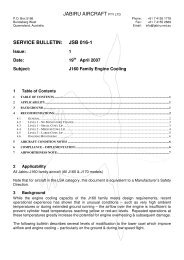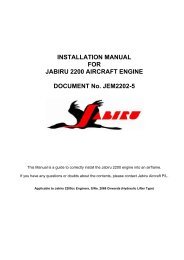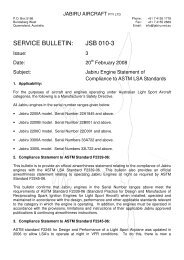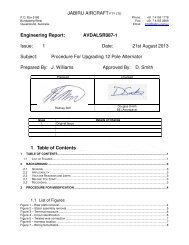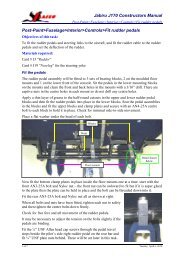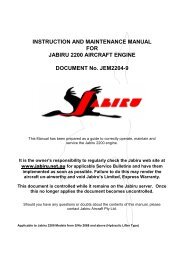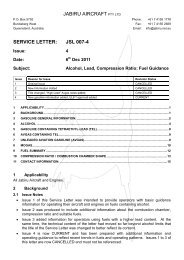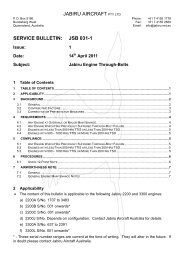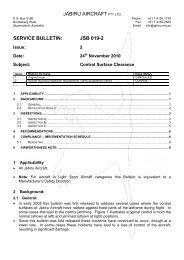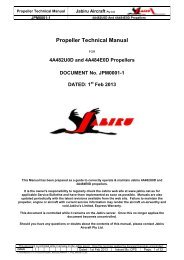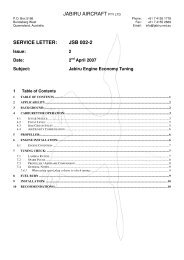INSTRUCTION AND MAINTENANCE MANUAL FOR ... - Jabiru Aircraft
INSTRUCTION AND MAINTENANCE MANUAL FOR ... - Jabiru Aircraft
INSTRUCTION AND MAINTENANCE MANUAL FOR ... - Jabiru Aircraft
You also want an ePaper? Increase the reach of your titles
YUMPU automatically turns print PDFs into web optimized ePapers that Google loves.
<strong>Jabiru</strong> <strong>Aircraft</strong> Pty Ltd<br />
Instruction & Maintenance Manual<br />
<strong>Jabiru</strong> 3300 <strong>Aircraft</strong> Engine<br />
Hydraulic Valve Lifter Models<br />
11.2 Normal Operation Notes<br />
The following are tips to ensure a long life. They are intended to bring attention to important<br />
aspects of caring for a <strong>Jabiru</strong> 3300 engine. For details on the required work, refer to the main body<br />
of this manual.<br />
11.2.1 Regular Checks<br />
With ignition and master OFF and throttle closed turn the prop by hand and observe engine for<br />
odd noises or heavy movements.<br />
Turn the engine over by hand before starting to check for regular compressions. If irregular<br />
(one cylinder with lower compression than others) a leak-down or similar pressure differential<br />
test should be done. If the results show a low-compression cylinder, contact <strong>Jabiru</strong> <strong>Aircraft</strong> or<br />
our authorized local representative.<br />
Compression Test: Condition of compression can be gauged by testing the engine with a<br />
compression gauge. The test is carried out with the engine warm, wide open throttle, ignitions<br />
OFF. Turn over on starter. A reading below 90 PSI may indicate removal of head and possibly<br />
cylinder.<br />
Pressure Differential Test: As an alternative to a compression test, a pressure differential<br />
test (Leak down) can be carried out. This is a much better test of the condition of rings, bore,<br />
head sealing and valve. This is the normal test used in aviation and requires specific<br />
equipment.<br />
The test is carried out with the engine in warm to hot condition. Pressure input of 80 PSI; a<br />
second gauge reads the differential. This is done with piston on TDC on the firing stroke. Note<br />
that the propeller needs to be restrained. A differential of lower than 80/60 indicates a problem.<br />
Problems can be better identified using the leak down:<br />
v) Blow by through the crankcase vent indicates worn rings or bore<br />
vi) Leaking from carby indicates a poor intake valve seal<br />
vii) Leaking from exhaust indicates a poor exhaust valve seal<br />
viii) Head leak indicates poor head to cylinder seal<br />
With the problem narrowed down, correction work can more easily be carried out.<br />
Your Tension Wrench should be accurate. It should be a “good” brand and have had some<br />
method of calibration. Even new wrenches can be un-calibrated and can vary to manufacturers<br />
claims.<br />
The Coil Gap can be adjusted easily by cutting a 15mm wide strip of plastic or thin card<br />
(thickness .010”). Place between magnets on flywheel and coil. Check both sides, that is each<br />
coil to each magnet (4 checks).<br />
11.2.2 Oil<br />
Use a non-compounded AVIATION oil:-<br />
Aero Shell 100<br />
Mobil Red Band (EXXON Aviation Oil 100)<br />
BP Aviation Oil 100<br />
Use for 20-25 hours, then drain and replace with a compounded AVIATION oil:-<br />
Aero Shell W100<br />
Aero Shell 15W50 (for cooler climates)<br />
This document is controlled while it remains on the <strong>Jabiru</strong> server. Once this no longer applies the document becomes uncontrolled.<br />
REVISION 0 1 2 3 4 5 6 7 8 9 Dated : Apr 2011 Issued By: DPS Page: 44 of 53<br />
L:\files\Manuals_For_Products\Engine_Manuals\3300_engine_manuals\Hydraulic_Lifters\Working_Copies\JEM3304-9_I&M.doc





